The AHS Blog

There’s never been a better time for reform!
This post was written by James Nye
A gauntlet has been laid down. Across Europe, thoughtful people are busy working up ingenious ideas for a competition devised over an extraordinary April weekend in southern Germany.
Each year, several dozen of the electro-horo-cognoscenti gather in Mannheim-Seckenheim for an event organised by Till Lottermann and Dr Thomas Schraven.
The fifteenth of these gatherings—a combination of market, lectures and much eating, drinking and good conversation—saw a new visitor who brought many interesting items, not least several hundred new-old-stock Reform movements, tissue-wrapped and boxed.
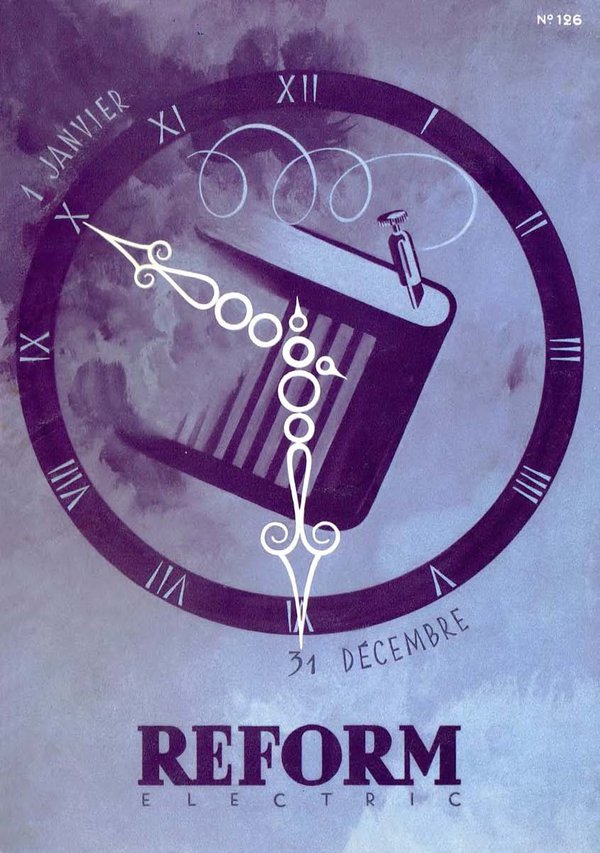

Alert readers will recall an Antiquarian Horology cover featuring a classic example of the Reform calibre 5000 movement, and a fascinating accompanying article.
As David Read comments, these Schild movements are ‘without doubt the best known and most commercially successful of all the many varieties of electrically-rewound clock movements’ from the 1920s onwards. The calibre 5000 is a lovely object, jewelled, with damascened plates, and micrometer regulation.
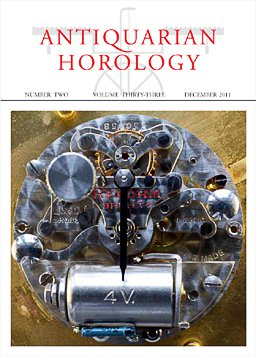

Nye’s theorem proposes that hi=as*bc/ebw where hi stands for horological inventiveness, as represents afternoon hours of sunshine, bc denotes beers consumed and ebw stands for evening bottles of wine.
With a lively group, talk over two sunny days and late evenings turned to possible creative uses for virgin Reform movements.
Given their looks, the mechanism must remain visible, but the motion work is to the (unremarkable) reverse. This led to discussions of projection clocks, or elaborate gearing to present time in the same plane as the movement, but to one side.
There was even intriguing talk of a large scale tourbillon. More detail than this presently remains closely held, but a competition to determine the best use was announced, to be decided in Mannheim in April 2015.
Reform is the order of the day.
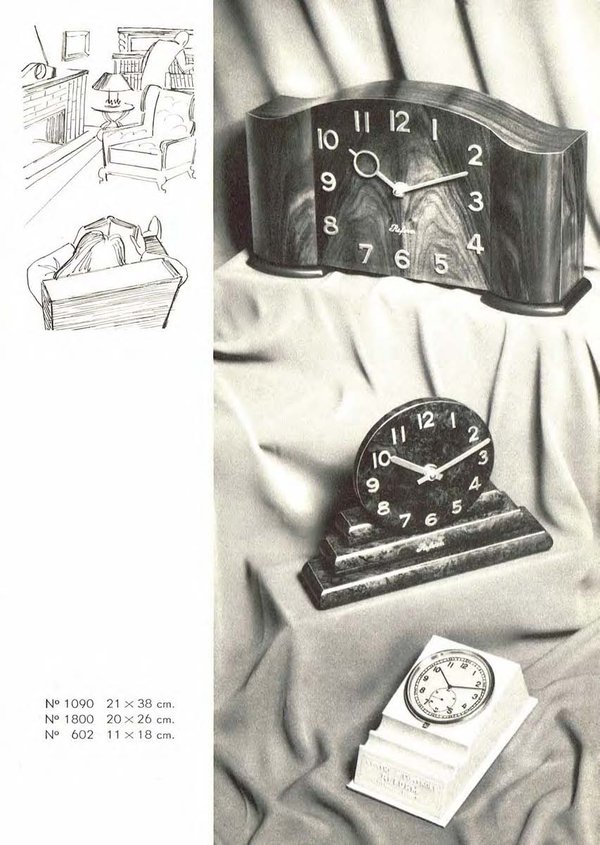
Of mice and clocks
This post was written by Peter de Clercq
In his most recent blog, Oliver Cooke discussed watches and clocks without hands as indicators.
Another example is the Mouse Clock, in which a mouse making its way up against a wooden board serves as time indicator. Its designer was inspired by the well-known nursery rhyme:
Hickere, Dickere Dock
A Mouse ran up the Clock,
The Clock Struck One,
The Mouse fell down,
And Hickere Dickere Dock.
The rhyme comes in various versions; this is the oldest, published in 1744 in Tommy Thumb’s_Pretty_Song_Book.
Could it be based on a real event: a mouse hiding inside a longcase clock, panicking when it struck?
In the literature I find only other explanations. One authority suggests it may be an onomatoplasm – an attempt to capture, in words, a sound; in this case, the sound of a ticking clock. Another relates it to the shepherds of Westmorland who once used ‘Hevera’ for ‘eight’, ‘Devera’ for ‘nine’ and ‘Dick’ for ‘ten’ when counting their flock.

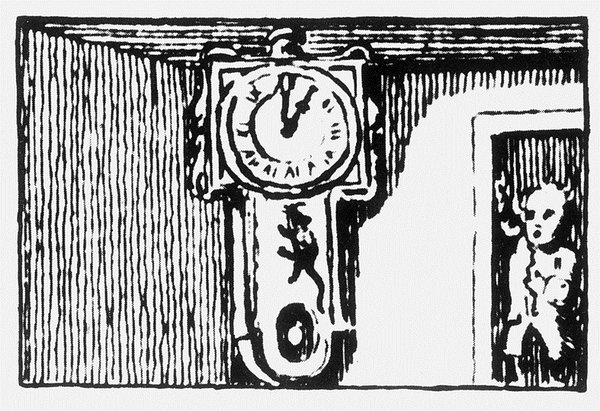
Be that as it may, just over a century ago it inspired an American businessman, who was also an avid clock collector, named Elmer Ellsworth Dungan, to develop the Mouse Clock.
He initially just created one for his daughter, who loved the nursery rhyme, but then decided to take them into production. He took out patents and various models were manufactured.
They are nowadays prized by novelty clock collectors, so much so that we are warned to beware of reproductions, especially for what one dealer calls ‘Chinese knockoffs’.



Details, including several images of the mechanism, and a link to an animated photo of the clock in operation, can be found on these American websites: Antique Clock Guy and Fontaine’s Auction Gallery.
In 1966 the NAWCC published a booklet by Charles Terwilliger, Elmer Ellsworth Dungan and the Dickory, Dickory Dock Clock; there is a copy in the AHS Library at the Guildhall.
And speaking of mice and clocks, how about having some fun with the (grand)children with this on-line clock reading game. Read the time correctly and the mouse runs up safely to the cheese in the clock. Read it wrong and the cat gets the mouse.
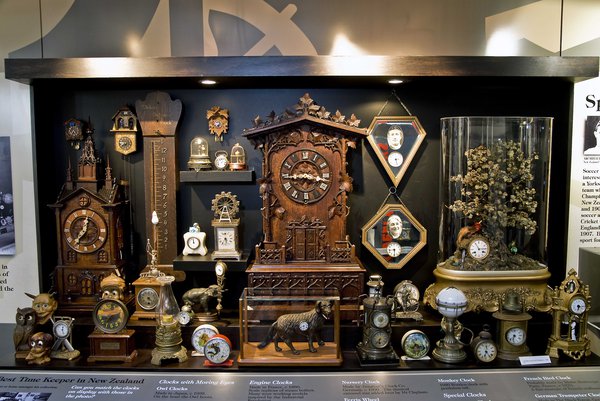
British Pathé films on YouTube
This post was written by David Rooney
In the latest in what seems to have become a short series on easy-access digital resources, I bring news that British Pathé has released its entire historical newsreel archive of 85,000 films onto YouTube, the video-sharing website.
British Pathé has long allowed people to see its historical newsreel films on its own website, and the release to YouTube doesn’t bring any change to the company’s copyright policy. But the findability of these often remarkable films will now have greatly increased, which can only be a good thing.
I have used British Pathé films in my historical research and my professional work curating museum exhibitions for years now, and it is therefore like meeting old friends to watch films on the YouTube channel such as The Golden Voice, Time Please and Standard Time.
For those with wider interests, I’ve also been moved seeing Comet Inquiry again, which appeared in the Science Museum’s recent award-winning Alan Turing exhibition. One of the AHS’s founder members, Alfred Basil Brooks, together with his wife, were killed in this tragic air crash which occurred just months after the founding of the society.
I think this film archive is strong in two ways beyond its sheer breadth.
Firstly, it helps to put technological objects and ideas into social and political context, which is crucial in understanding why people make, modify, use and choose things. Objects never emerge fully-formed in a contextual vacuum.
The second strength of the films is the technical understanding they can offer those studying particular technologies. There’s nothing like the moving image to bring dynamic objects to life.
So there we are. Another great digital archive of work made even easier to use. And along those lines, AHS members should watch out for an important announcement in the next few weeks. We’ve been working on something pretty special and we’re about to be able to share it with you…
You can find the British Pathé channel at https://www.youtube.com/user/britishpathe. Search by clicking the little magnifying glass symbol in the middle of the page underneath the header image.
Time in Old Bohemia
This post was written by David Thompson
Many thousands of people today have stood amazed in front of the Astronomical Clock in the Old Town Hall Square in Prague, but I wonder just how many have managed to make sense of the dial. In modern times, perhaps it makes little sense.

The clock was made by Jan Šindel in about 1410, and from as early as the 15th century, the clock had a 24 hour dial which showed the so-called Bohemian Hours, a system in which the day began and ended at sunset.
This means, of course, that the 24-hour ring around the outside had to be adjusted periodically so that the 24th hour coincided with sunset.
In the early part of the clock’s life this was done manually, but later an automatic mechanism was installed to adjust the position of the ring. In medieval Prague, a knowledge of how long it was to sunset and the imposition of curfews in the city was useful knowledge. For instance – a simple glance at the dial indicating 19 hours tells you straight away that it is five hours to go before sunset.
As well as telling the time, the dial also has moving sun and moving effigies of the sun and moon, showing where in the zodiac they lie throughout the year. Useful astrological information.
The ecliptic circle with the zodiac signs and the sun and moon effigies rotate together once per day, but gradually over the course of the year, the sun and moon effigies with make a complete circle of the zodiac.
All this is achieved by some sophisticated gearing located behind the dial and driven by the clock mechanism in the tower. With the horizon circle with shaded buff areas, the periods of Aurora and Crepuscular, dawn and dusk are also shown,
Today, the clock is controlled by a more modern ‘regulator clock made by Romuald Bozek in the 1860s, but for the most part, the clock mechanism is still that which has been in existence from the beginning of its history.
Looking at the illustration here, you will see that the time is just a few minutes past 13 hours. On the fixed chapter circle the time is shown just before IX o’clock in the morning and hour 24 is just before 8 o’clock in the evening – correct for a July date. The sun is in Leo and the moon is in Aries.
So next time you stand in front of this amazing clock, you can really show off by knowing how to read the dial.

Look no hands!
This post was written by Oliver Cooke
On the one hand we have looked at single-handed dials, on the other hand we have looked at some more unusual forms of indicator. Here we will look at indicators with no hands at all.

This watch has a display with digits formed of light emitting diode (LED) segments, seven for each numeral.
LED watches were first introduced in 1970 by the Hamilton Watch Company and were soon followed by liquid crystal display (LCD) watches. LED and LCD were by no means the first technology to enable digital displays however.

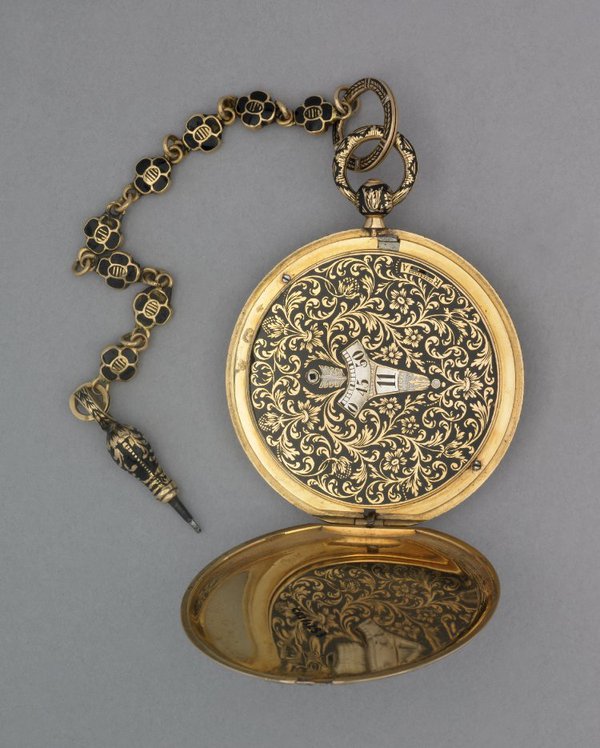
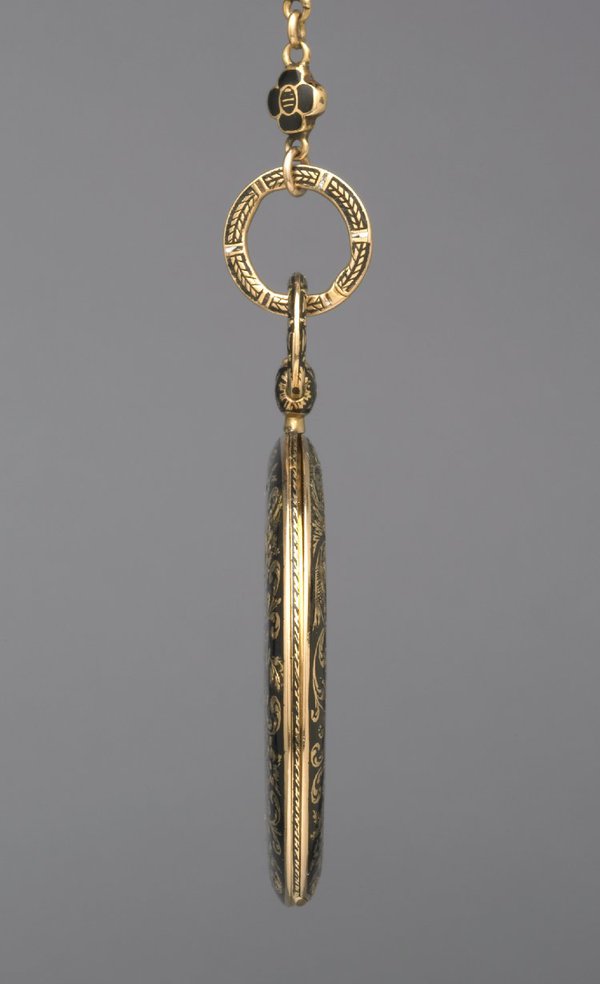
Before these examples existed the 'wandering hour' dial, something of a mash-up of digital and analogue time indication.
The hour numeral wanders, from the left-hand position (as viewed), up-and-over the semicircular aperture during the course of an hour. As the current hour ends and disappears behind the dial plate, the next hour numeral appears on the left.
We see 12:14 indicated on the illustrated example.
The system was invented in the 1650s by the brothers Tomasso and Matteo Campani from San Felice in Umbria, as a means to enable the time to be read at night (the numerals are pierced, allowing the light of an oil lamp to pass through from behind). This was very useful in the days before instant electrical lighting.
The wandering hour dial was also, occasionally, used on watches in the late 17th century, (but an oil lamp was not fitted in these!)
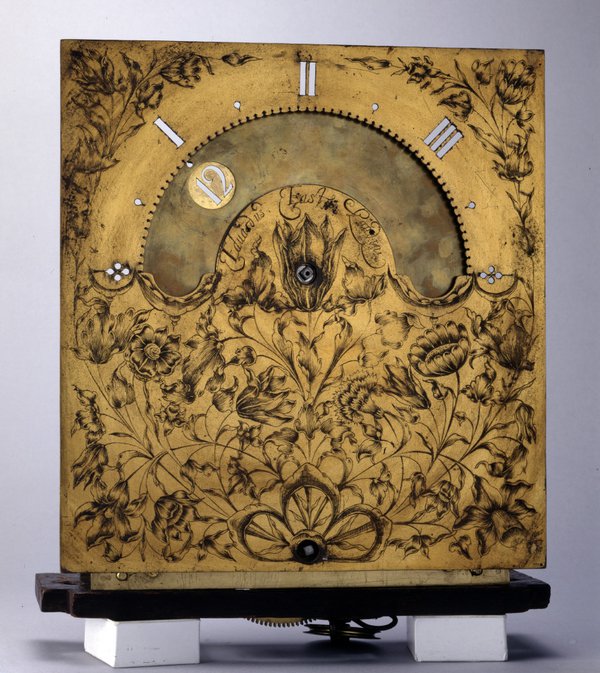
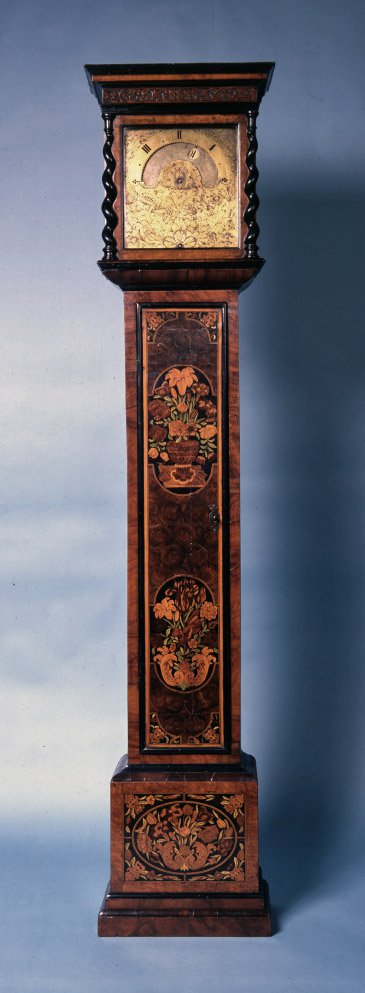
Finally, this watch also blurs the distinction between analogue and digital.
It has an LCD but, instead of digits, it has radial segments representing hands. This, however, requires 120 segments instead of the 42 needed to make up a standard six-digit digital display.
Together with the corresponding electronics needed to drive each segment, this means that these “LCA” watches cannot be made as cheaply as their digital counterparts. Perhaps for this reason they have never been popular, but they must have an adequate, if small, number of fans as they seem to have always (just) remained in continous production by one manufacturer or another since the 1970s.
I wonder how many of their fans, like I, appreciate them mostly for the futility of over-engineering, to achieve a result with LCD that is much more easily and better obtained with physical hands!
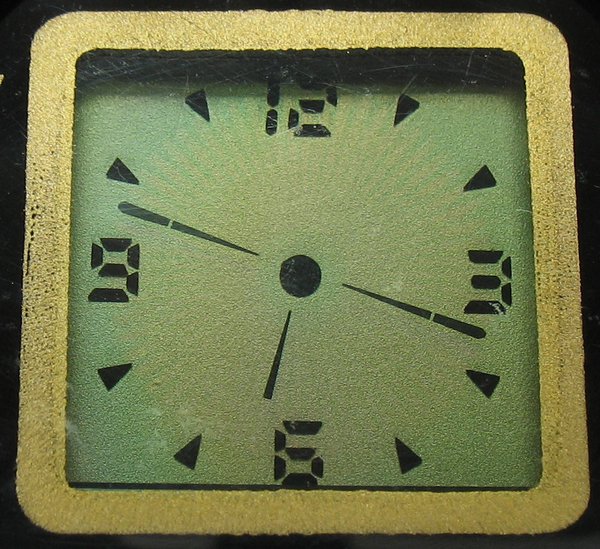

Clock world full of cranks?
This post was written by James Nye
Things turn up. Back in 2006, when David Rooney and I were researching the Standard Time Company (STC), we planned a lecture at the Guildhall library.
The only surviving early clock we knew of had spent its life at the Royal Observatory—but out of the blue, days before the event, a Lund-synchronised dial clock turned up.
In the following eight years, that was it—nothing else—and then suddenly, through the kind agency of Keith Scobie-Youngs, The Clockworks acquired a wonderful addition a few weeks ago, in the form of an outsized fusée gallery movement, fitted with a massive Lund synchroniser.
The movement is by Thwaites, from the early nineteenth century, and signed elaborately by Metcalfe of 122 Newgate Street, London.
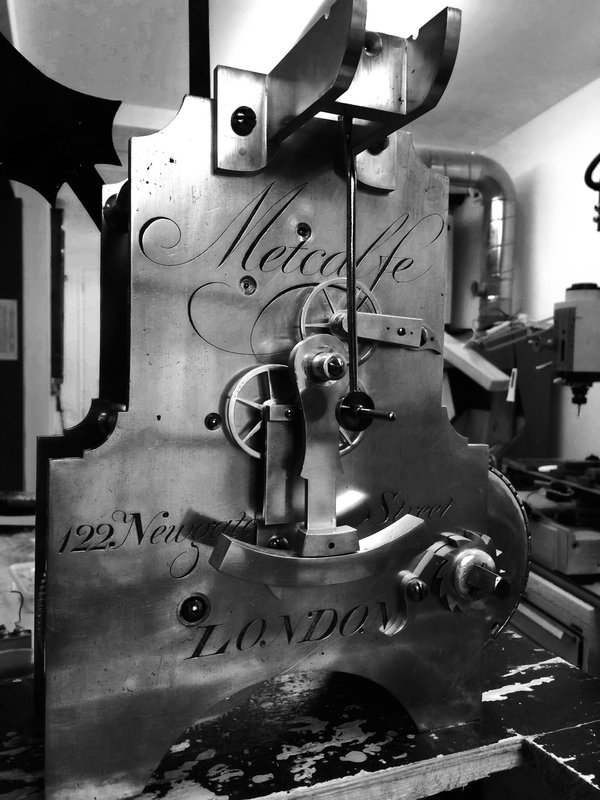
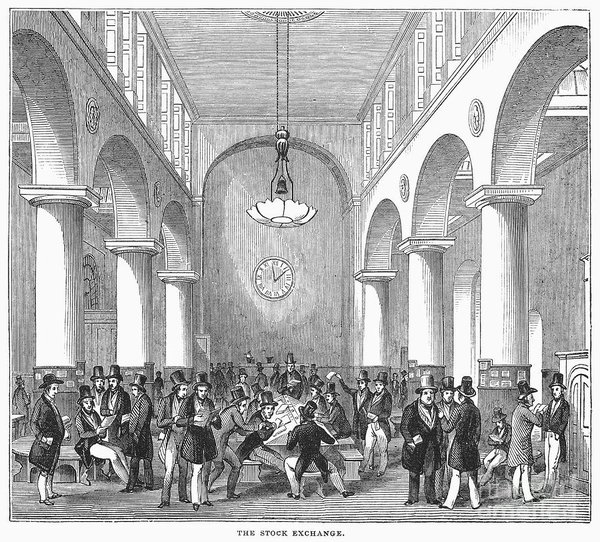
When STC went public in 1886, it listed its clients in the prospectus, and the very institution on which it was being floated appeared second in the list.
The accurate timing of bargains made by the jobbers on the London Stock Exchange was an important matter, and ‘the House’ was an early adopter of the new technology that provided hourly synchronisation of its clocks.
Remarkably, our new addition was one of probably several STC-synchronised clocks that populated ’Change, where it seems to have served for some time.
Each hour, a signal would travel from STC’s offices on Queen Victoria Street around a series of looped networks, energising the coils of the synchronisers. These were the ‘set-top boxes’ of their day, added perhaps many decades after a clock was first made—as was clearly the case with this clock.
The Stock Exchange synchroniser is particularly large, operating two small fingers that project through the dial, to correct the minute hand each hour. The long use of the device is evidenced by the deeply indented witness marks in the tab on the back of the hand, caught by the synchroniser.
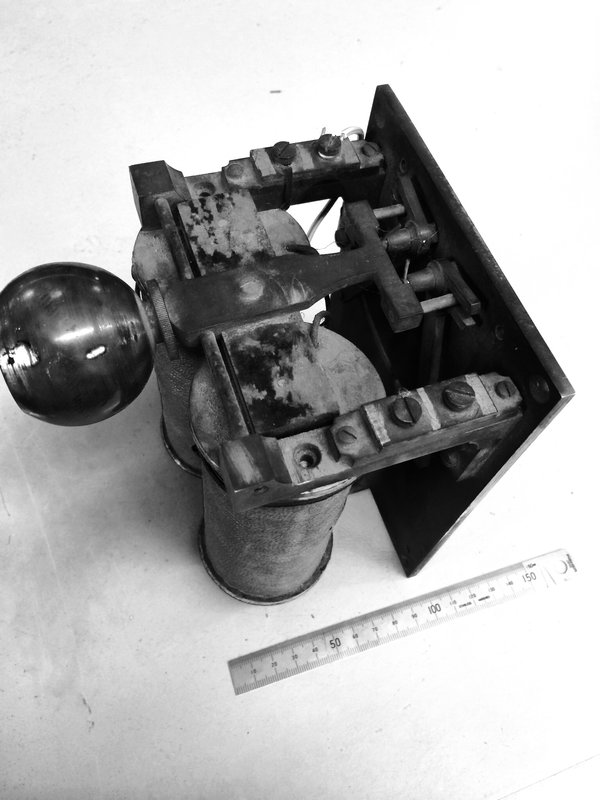
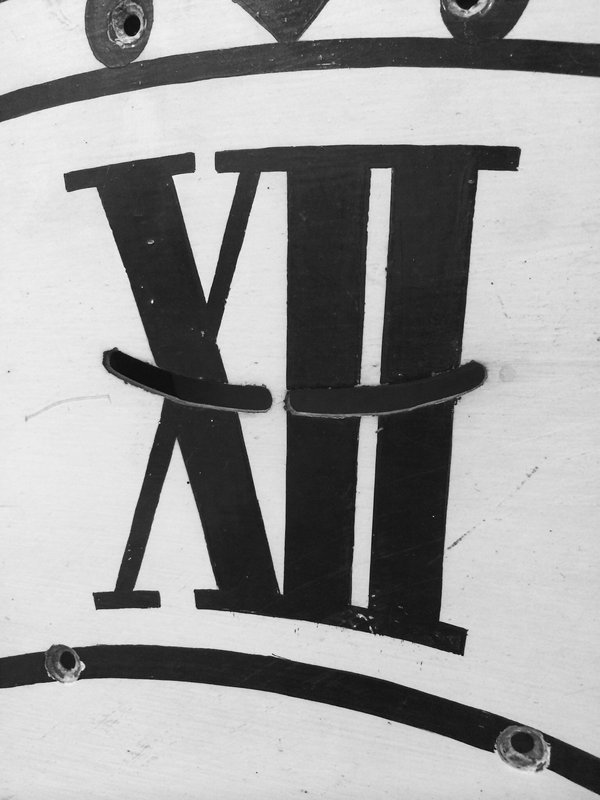
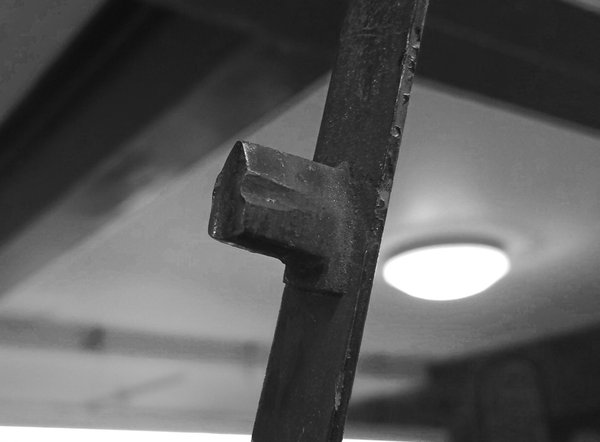
.
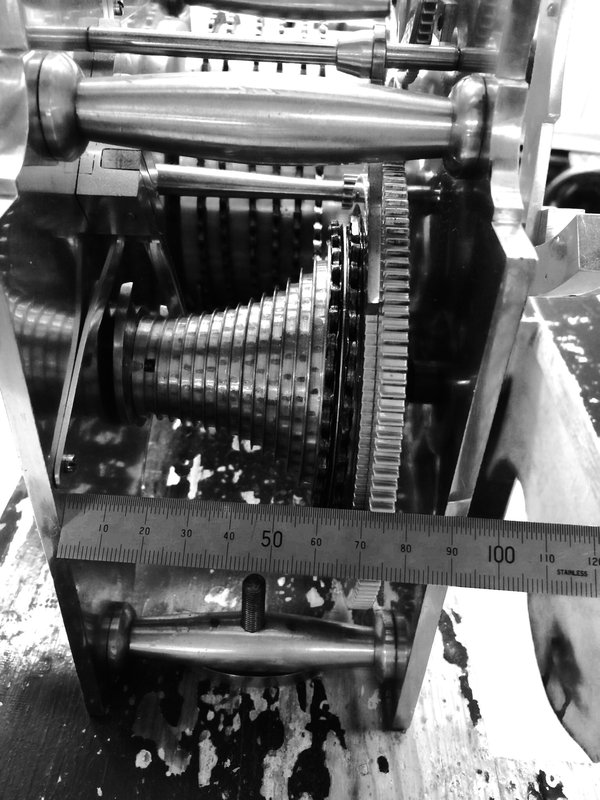
Overall the movement seems rather outsized for the scale of the dial it ended up supporting—the large counterweight is much more than a match for the 15-inch minute hand.
Sometimes, it’s very hard for us to trace the environs in which our clocks spent their time—and to deduce whose lives they counted out. Thankfully in the case of this remarkable STC clock, there’s an old crank that can tell us a story or two.

Stopping the clock after death
This post was written by Peter de Clercq
In a previous post I included an opera scene, in which a woman mentions (sings!) that at times she stops all the clocks in her house. She dreads getting old and wants time to stand still.
One reader told me this reminded him of a poem by W.A. Auden which begins:
'Stop all the clocks, cut off the telephone.
'Prevent the dog from barking with a juicy bone,
'Silence the pianos and with muffled drum
'Bring out the coffin, let the mourners come.'
But here the motive for stopping the clocks is different. Someone has died, and stopping the clocks in the house of the deceased, silencing them, is an old tradition, similar to closing the blinds or curtains and covering the mirrors. The clock would be set going again after the funeral.
Some people believe stopping the clock was to mark the exact time the loved one had died. The subject was discussed here by members of the NAWCC, the National Association of Watch and Clock Collectors in America.
The French film Jean de Florette, set in the Provence between the wars, contains such a clock-stopping scene. The film is made after a novel by Marcel Pagnol, from which the following quotes are taken.
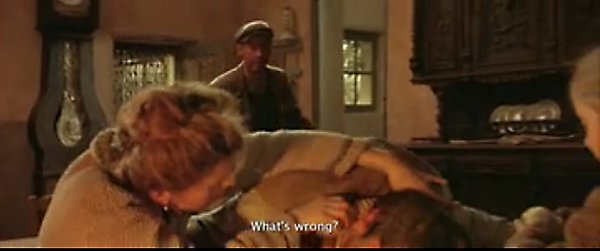
Jean, an outsider, inherits a house with surrounding land and hopes to make a living there. But two locals, who covet his land, secretly block a source, cutting off his vital water supply.
In despair, Jean uses dynamite to create a well, but he dies as a result of the explosion (chapter 37). The doctor, taking his pulse, 'listened for a long time in a profound silence emphasized by the ticking of the grandfather clock', but the man had died.
Then one of the two devious locals, who was in the room, 'crossed himself, walked around the funeral table on tiptoe, and stopped the pendulum of the grandfather clock with the tip of his finger'.
He then tells his comrade in arms 'Papet, I have just stopped the grandfather clock in Monsieur Jean’s house' – a way of saying: he is dead.
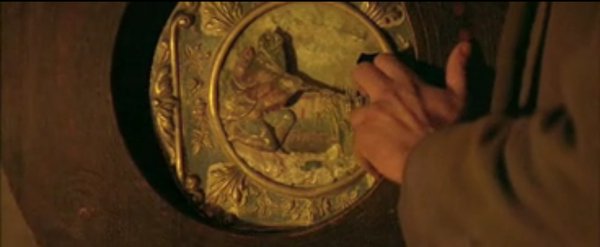
The three stills reproduced here are from that scene, which you can see in this short clip.
The clock is a typical Comtoise grandfather clock with a big flower pendulum.

100,000 more free images
This post was written by David Rooney
When I got an email from the Wellcome Trust which began, ‘we have some very important news to announce’, it certainly got my attention.
And they were right: it is very important news indeed, and I’m delighted to share it.
In my last post I talked about the recent release of a million images by the British Library. Already I’ve heard from colleagues and friends who say they have found new evidence amidst its vast collections that is crucial to support their research.
The news from the Wellcome Trust is the same. As of January this year:
'All historical images that are out of copyright and held by Wellcome Images are being made freely available under the Creative Commons Attribution (CC BY) licence. This means that they can be used and manipulated freely, for commercial or personal purposes, so long as the original source is acknowledged.'
You can download high-resolution files directly from their website. There are 100,000 images dating from as early as 1000 BCE. You can even get advice directly from Wellcome’s team of researchers, should you be having trouble finding what you need.
Like many in the AHS, I’m interested not only in clocks and watches themselves, but how horological machinery gets embedded in other technologies. So I searched for ‘clockwork’ and, rather than showing you the clockwork trephine (not safe for suppertime), here’s a clockwork picture of an itinerant dentist performing an extraction in the early 19th century. Ouch.
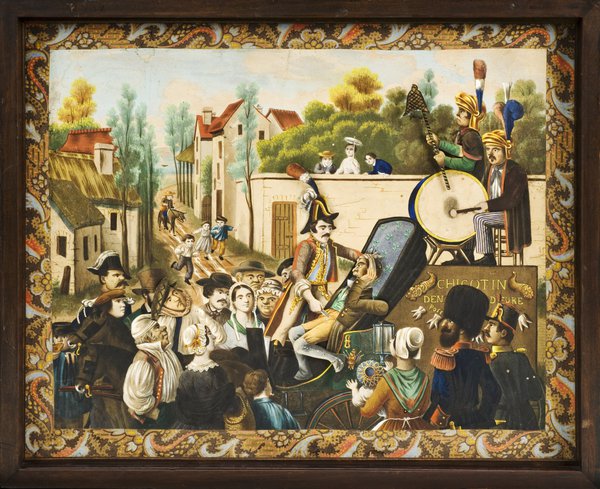
Whether you’re into automata like this, or medical technology, or astrology or philosophy or geology or anything else related to stories of time and its material culture, you’re sure to find something here to delight.
As I said last time, image banks such as this are invaluable treasure troves of historical evidence for researchers, whatever your subject. Serendipitous browsing leads to new leads and new ideas.
Huge thanks to Catherine Draycott and others at the Wellcome Trust (as well as the British Library) for making such a bold and generous decision to open this to everyone.
The Battle of the Three Emperors – or the Battle of the Three Dates
This post was written by David Thompson
I was recently reading Dušan Uhlír’s book The Battle of the Three Emperors and I came across an intriguing fact about the battle of Austerlitz which took place on the 2nd December 1805 between the armies of Emperor Francis II of the Holy Roman Empire Empire and Tsar Alexander I of Russia against their invading enemy, Napoleon Bonaparte.

In Uhlír’s fascinating account of one of the most famous battles of the Napoleonic campaign, excepting Waterloo of course, he points out that the battle took place on a different day for each of the three armies.
For Francis II, the date was 2nd December 1805, for Alexander and the Russian army the date was 20th November and for Napoleon, Bonaparte it was 11th Frimaire year XIV.
Francis and his army were using the Gregorian calendar introduced in 1582, although it was not universally adopted throughout Europe – indeed, England didn’t change until 1752. Alexander was still using the old Julian calendar – the Russians did not change to the Gregorian calendar until 1918. Napoleon was using the French Revolutionary Calendar, introduced in 1793, but back-dated to September 1792 to mark the beginning of the new republic and each successive year numbered from then on.
It must have caused some confusion for the Austrians and the Russians when agreeing a date to face up to Napoleon and the French would have had to convert the traditional dates into their new scheme.
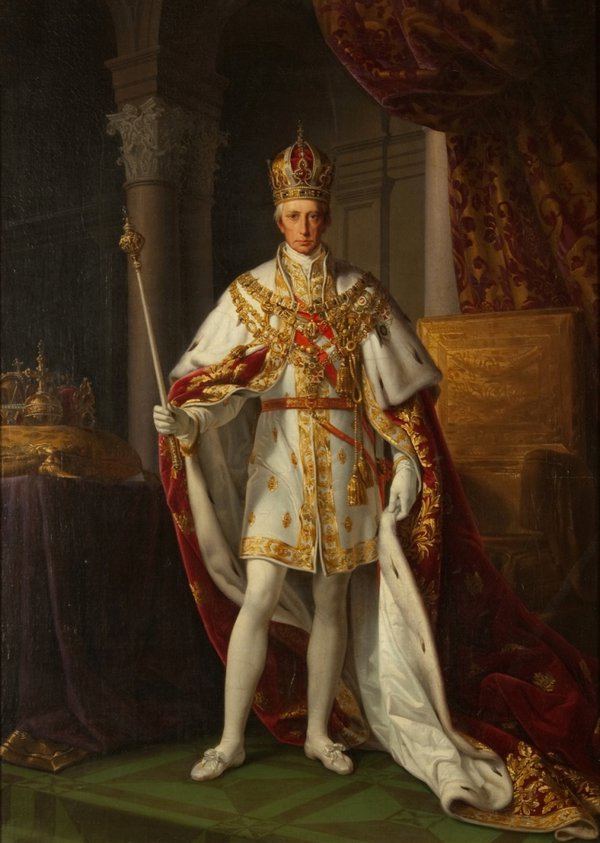

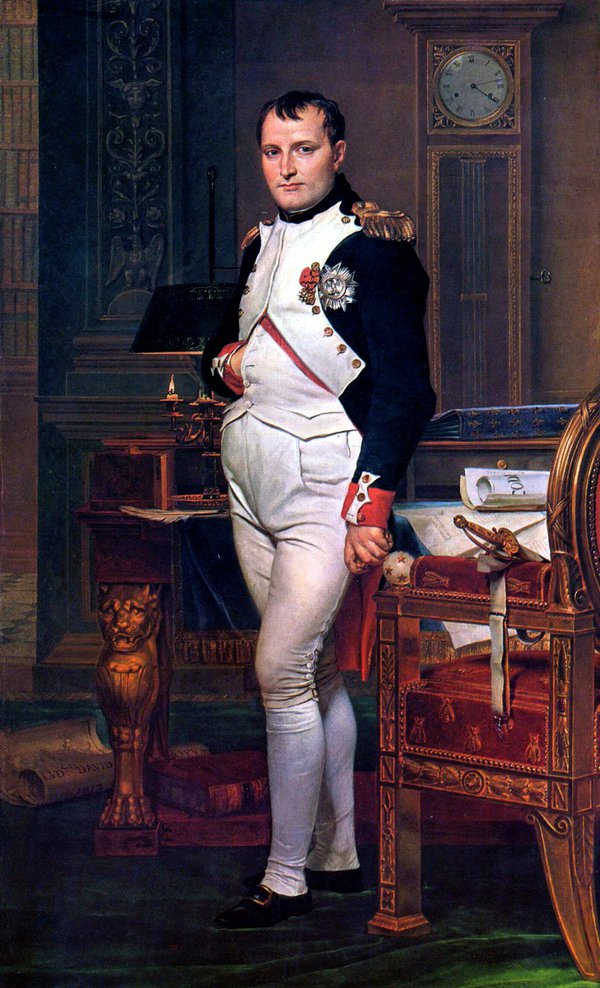
…on the other hand
This post was written by Oliver Cooke
On the one hand we have simple, easy to use, single-handed dials. On the other hand, some dials are not so straightforward.
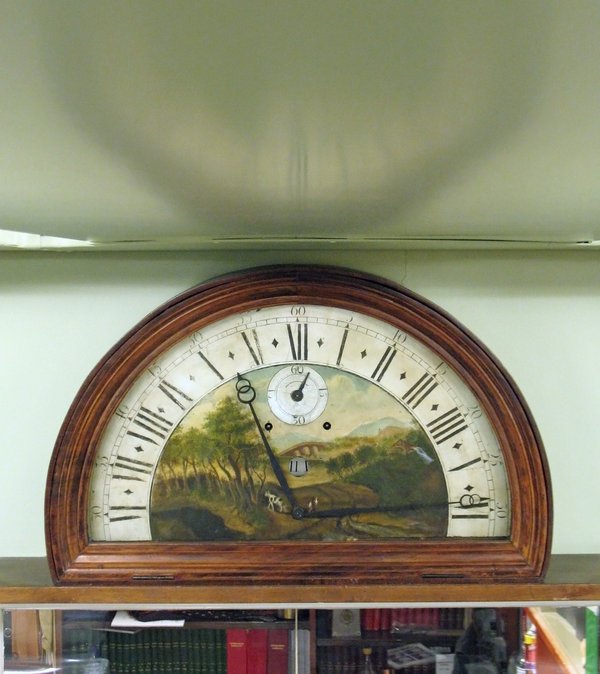
This clock has 'fly-back' or 'retrograde' hands. The hands proceed clockwise as usual but when they reach the end of the scale, each will spring back and then immediately resume its count.
This design allows the dial to have twice the diameter of a circular dial within a given height. This, together with the semi-circular form, makes these clocks suitable for positioning over doorways and they were sometimes integrated within wall panelling.
Fly-back hands are still a popular feature in watches, although these are usually (but not always) the preserve of high-end watches.
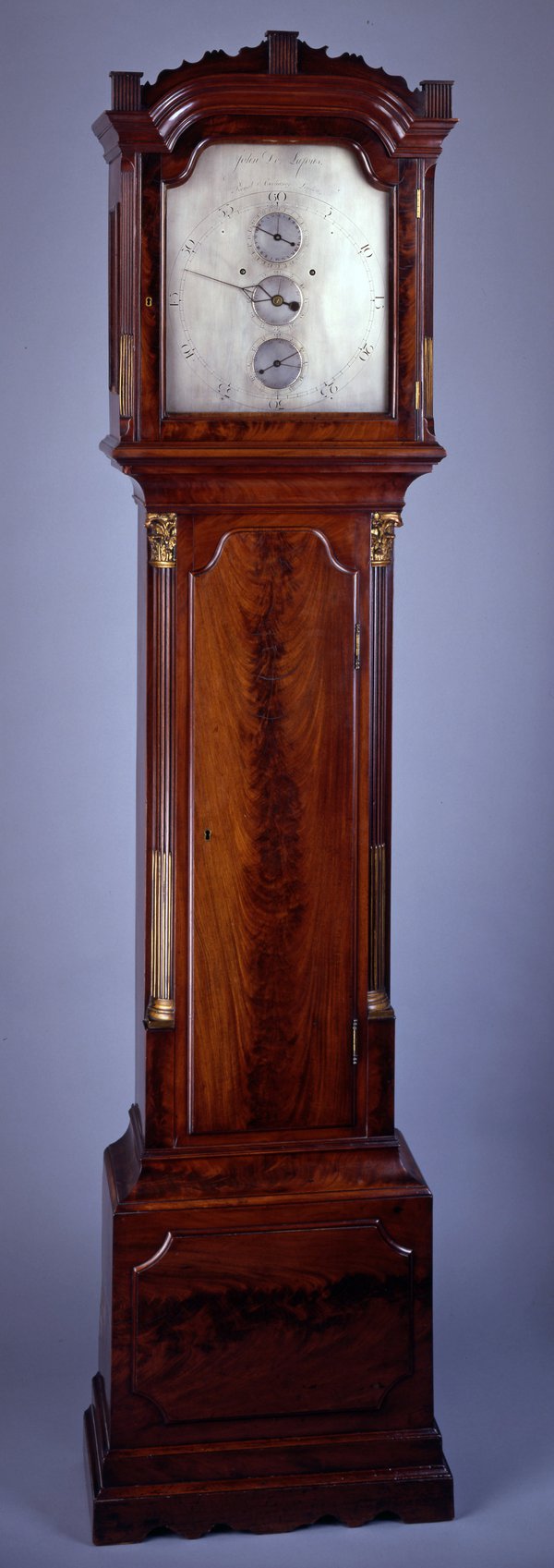

The dial of this regulator (that I have mentioned before for its escapement) has the typical features which facilitate the use of these clocks in observatories and laboratories. All hands are positioned on their own centres for disambiguation. The hours are relegated to a small subsidiary dial and only the minutes have a large hand, for accurate observations.
Less typically, however, this regulator indicates two different systems of time using only one set of hands.
It shows mean sidereal time against the numerals on the main dial plate and mean solar time against the small discs. A mean sidereal day is 23 hours 56 minutes and 4.1 seconds, i.e. it is about 4 minutes shorter than the 24 hour mean solar day. The discs rotate slightly faster than the hands so that after each day they have accrued the 4 minutes difference. This system is called a differential dial.
Having a clock show both sidereal and solar time might have been a convenience, but a respectable observatory might well be expected to have had separate regulators for providing the required times and so it is possible that this design may have been conceived rather for the use of the (wealthy) amateur.

This watch has not just hands, but arms and fingers too! It is a type of watch known as “bras en-l’air”, which translates as “hands in the air” (and certainly not “bras in the air” – which might apply another aspect of horology altogether). When the pendant is pushed the soldier raises his arms, holding pistols to point at minutes (left) and hours (right).
An experiment in ‘florology’
This post was written by Rory McEvoy
Recently, I have been looking at the role of timekeepers in the history of science and whilst reading around the pre-pendulum era, happened upon a blog-worthy experiment conducted by Athanasius Kircher (1601/2-80).
Kircher, a German Jesuit polymath, applied the then known phenomenon of heliotropism as a method of timekeeping.
He thought that the daily motion of sunflowers as they followed the Sun was caused by magnetic influence and thus inferred that they could be usefully used as a clock. As can be seen in his magnificent illustration, Kircher planted the sunflower in a cork pot and floated it on water, providing a frictionless pivot, and inserted a pointer through the flower to indicate time against the annular chapter.
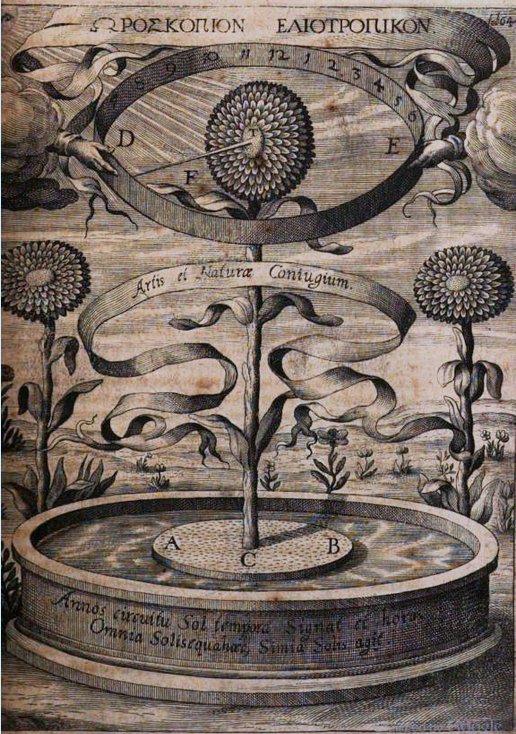
Kircher noted that his clock was disturbed by the slightest of breezes and, when kept away from sunlight, it withered and its motion slowed. This, however, did not end the experiment. He tells us that he had the good fortune of meeting an Arab trader who happened to have amongst his aromatic wares a substance with similar horological properties to the sunflower.
The deal was struck and Kircher parted with his sundial signet ring for the horological stuff.
It has to be said that this episode is possibly a theatrical device to colour the account and introduce the use of sunflower seeds and root instead of the plant itself, but worth repeating – even if it’s just an excuse to show a beautiful horizontal sundial ring!
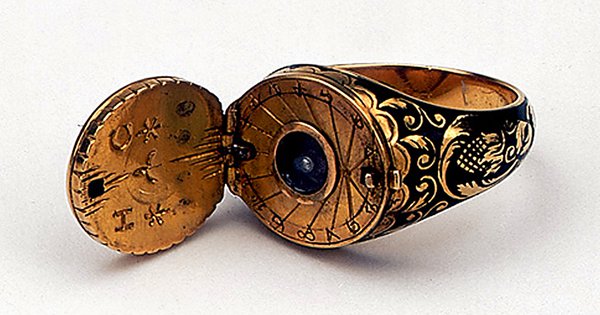
Today, we know that this diurnal motion is caused by sunlight and so Kircher’s clock could never have worked in the way intended, but one cannot help admire his ingenuity in applying a mystery of the physical world to tell the time. M. Becker’s 2011 time lapse movie shows that it is possible to use a flower as a twenty-four hour clock, but only in summertime at a latitude close to the north or south pole.
Graveyards, clocks and bombs
This post was written by James Nye
Things end up in graveyards at the end of their lives, but monuments to the passing of much else can be found in other locations.
I live in West Norwood, home to one of the ‘magnificent seven’ London cemeteries.

On its eastern boundary lies the Park Hall Business Centre. This thriving modern enterprise occupies the former Hollingsworth Works of the Telephone Manufacturing Company (TMC).
This firm did just what its name suggests, but was also a prolific maker of industrial timekeeping systems, rented out under the name Telephone Rentals. TMC’s ‘TEMCO’ synchronous clocks are featured in the latest NAWCC bulletin.

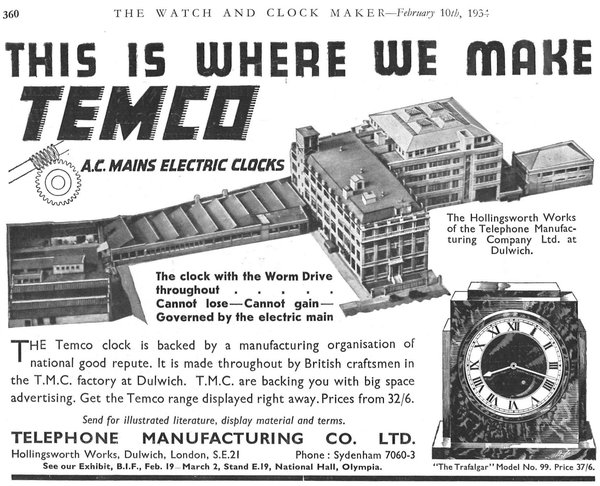
TMC occupied the Dulwich site from the early 1920s, employing a large local workforce—1,600 by 1937. Workers from the other side of Norwood Road used to talk of ‘walking the wall’ to work, following the long cemetery flank wall, down Robson Road.

Involved in contemporary ‘hi-tech’, the factory was a natural wartime target—Gerald Wells’ extraordinary autobiography describes twenty-seven bombs falling on the cemetery, targeting TMC, but then the Luftwaffe became:
‘fed up with wasting bombs on Norwood Cemetery so they decided to get the TMC factory by lowering a large naval magnetic mine on a parachute over the building. My sister Margaret watched it come down from an upstairs window […] it knocked seven colours of s*** out of our little Congregational Church’ ( click for a bombsight map —work in progress).
So Hollingsworth Works survived, and TMC/TR had a more successful post-war life than many clock-related concerns.

You can learn much more about the company’s life and products from a superb paper by Derek Bird—these technical papers are a feature of EHG membership. Why not e-mail me to get on board? And put 7 September 2014 in your diaries—part of Lambeth History Month—when The Clockworks will offer a special locally-themed event, featuring TMC.
Musical clocks
This post was written by Peter de Clercq
My previous post in this blog was on clocks in opera. How about opera in clocks?
The Handel House Museum is the London home where the composer George Frideric Handel lived from 1723 until his death in 1759. In the 1730s, Handel provided music for a series of musical clocks created by the watch and clockmaker Charles Clay.
These more than man-sized, elaborate pieces of furniture were fitted with chimes and/or pump organs that at the hour and every quarter played musical excerpts from popular operas and sonatas.
Until 23 February the Handel House Museum presents an overview of Clay’s clocks in an exhibition ‘The Triumph of Music over Time’. The centrepiece is a clock on loan from the Birmingham Museum and Art Gallery; other clocks are presented as photos on text panels.
These panels are all on-line here where you can also listen to some of the music that Handel arranged for Clay’s musical clocks, including two pieces from his opera Arianna in Creta. So there you have it: opera in clocks.
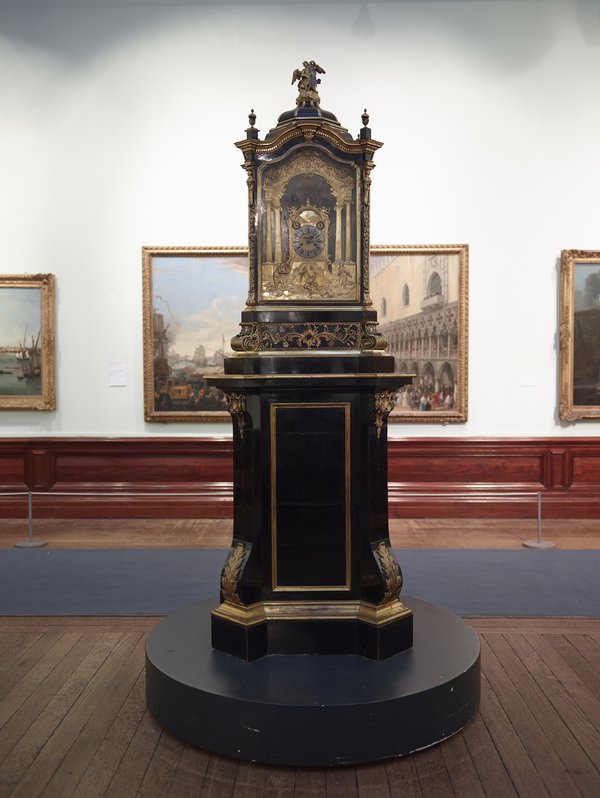

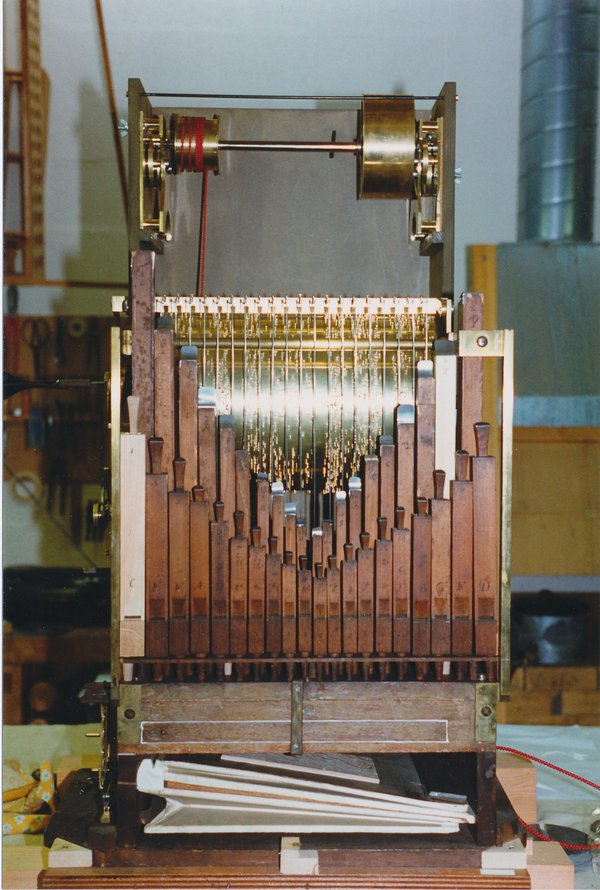
Another 18th century maker of beautifully crafted musical clocks was George Pyke. A fine example, dated 1765, is on display at Temple Newsam House in Leeds.
Standing over 6 foot tall on its pedestal, it strikes the hours and has a pipe organ that plays eight tunes. The innards of the Pyke clock are shown below; more photos and details of the clock are here on the website of Brittany Cox, who has made a condition study of the clock and hopes one day to be able to restore it to its former glory.

Although a bit off topic – it is not a clock – you may like to know of a musical automaton that Brittany Cox restored to working order during her studies at the Clocks and Related Dynamic Objects Department at West Dean College. A miniature ship, a mere 15mm wide, rocks to and fro, as in a storm, while ‘God Save the King’ plays on a plucked comb; see and hear it here.
For this project Brittany was awarded the annual AHS prize for 2012. For a full description see this article which she wrote for our journal Antiquarian Horology .
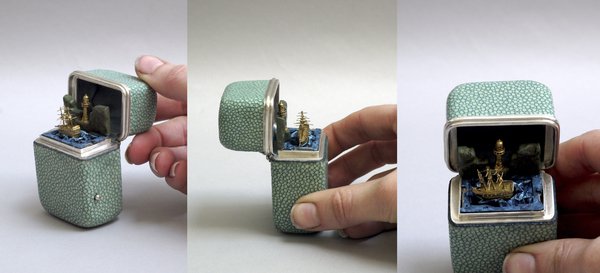

With thanks to Ella Roberts, Communications Officer at the Handel House Museum, for her help.
A million free images
This post was written by David Rooney
Just before Christmas, the British Library released over a million historical images from its printed collections onto the image-sharing website Flickr. The images are out of copyright and the library has made them available with a Creative Commons licence which, in short, encourages anybody to use, remix and repurpose them, so long as they respect a few ground rules.
This is a remarkable resource of imagery and will be a boon for anybody carrying out historical research – such as AHS members.
There are countless images of interest in this release, each one of which might augment an existing research project or prompt a new one. The beauty of archives such as this is the opportunity for lateral thinking. You might be researching a particular village, or writer, or building, or period. And you might find an image here that opens up new avenues of research.
The first four images I found are the result of searching for ‘clock’ or ‘clocktower’ – as you’d expect, lots of public clocks.
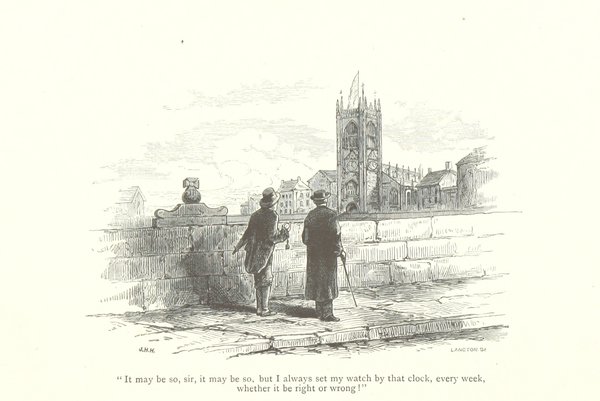
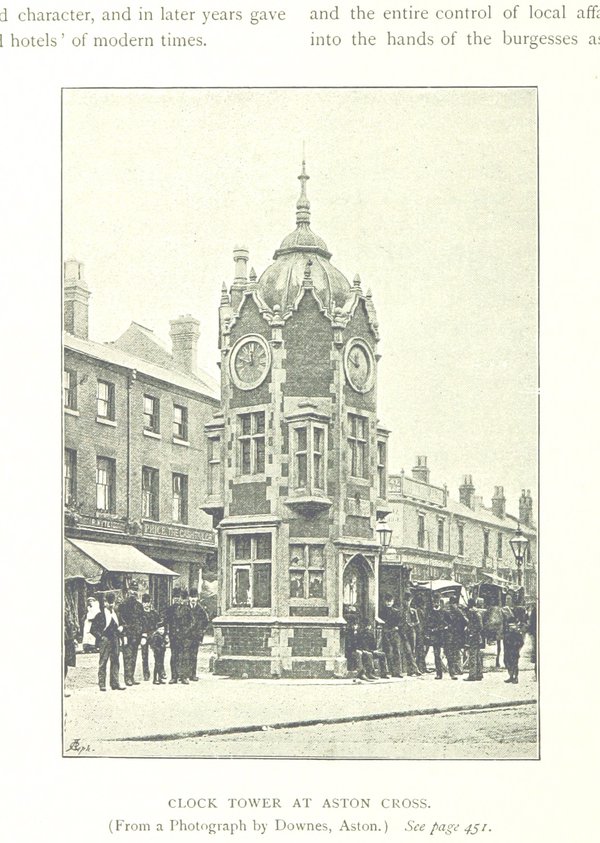

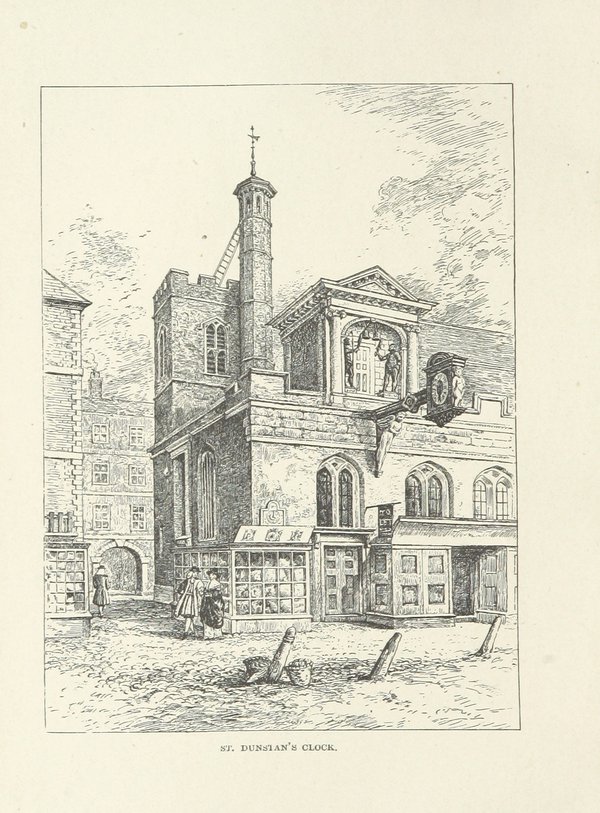
But let’s say I’m interested in chronometers. Unfortunately there are no search returns for that word. But then I tried searching for ‘observatory’, and found this image.

It’s from a book on the North Polar Expedition, and it’s a photograph of marine chronometers on show in a US Navy centennial exhibit in 1876.
That led me to this catalogue of the objects exhibited. And on pages 79–81 there’s a remarkable and detailed description of the use of chronometers at the US Naval Observatory in the 1870s. Serendipitous discovery is a wonderful thing.
You’ll probably want to put aside an hour or two browsing these images – and a lot more time following the interesting leads they throw up! Happy hunting, and happy new year.
The sands of time
This post was written by David Thompson
Everyone is familiar with the egg timer, but just how far back in history do these glass timers filled with free-flowing material go?
The earliest known illustration of such a device exists in an Italian fresco dating from between 1337 and 1339 in the Palazzo Publico in Siena. The fresco is called ‘The Allegory of Good Government’ and in it, one of the figures can be seen holding a sand-glass.
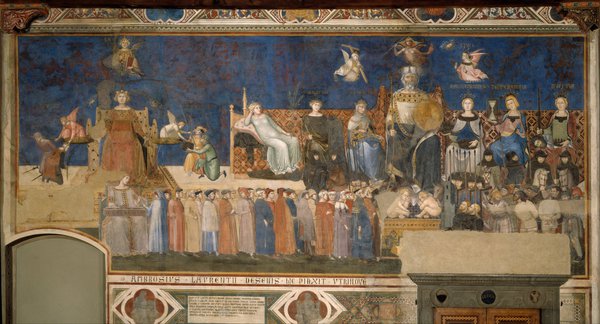

Before modern glass making techniques developed, sand-glasses were made using two separate bulbs bound together around a disc with a hole for the ‘sand’ to pass through. Over the centuries all manner of different materials were tried in attempts to achieve a uniform free-flowing performance.
The duration of the timer depended firstly on the amount of ‘sand’ in the glass, and secondly on the size of the opening between the two containers. The two glasses were sealed together with wax and the joint covered and tightly bound. The biggest enemy for these glasses was humidiy – damp ’sand’ was bad for business.
A particularly fine example exists in the British Museum collections, although is has a rather dubious reputation.
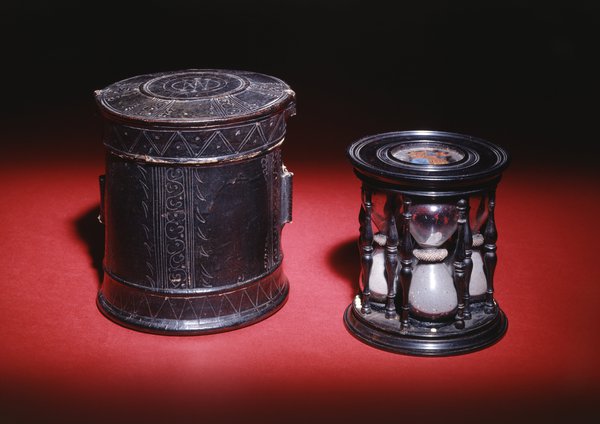


It is a composite glass with four separate glasses in a beautiful ebony frame and each glass is designed to run for a different period, one quarter, one half, one three quarters and last a full hour. It even boasts a leather carrying case.
At one time it was said to have belonged to Mary Queen of Scots and indeed, at the top and bottom of the frame are reverse-painted glass discs bearing the royal shield of the Tudors and the shield of France with fleur-de-lys. The idea was that this glass was owned by Mary Queen of Scots and Francis II, king of France.
Unfortunately, the Tudor arms are from the wrong period and the lion rampant in the first quarter of the shield is the wrong way round. The leather case is also roughly embellished with the monogram MF for Mary and Francis.
In spite of its later enhancement, this is nevertheless a very fine example of a late 17th century glass.

On the one hand
This post was written by Oliver Cooke
The last of the five elements is the indicator, the part of the clock or watch that conveys the time.
Early clocks and watches typically only had a single, hour, hand. This was more than adequate for indicating the time as these foliot-controlled timekeepers would typically lose or gain at least quarter of an hour in a day. Minute and seconds hands only became truly useful with the vast improvement in timekeeping that came with introduction of the pendulum in 1657 and the balance spring 1675.
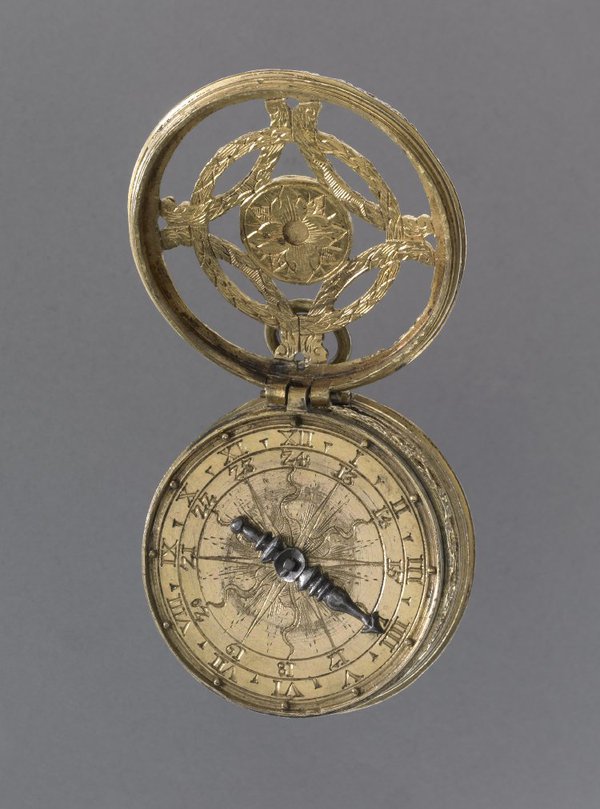
However, the familiarity, simplicity and economy of the single hand meant they never became obsolete. Throughout the 18th century, pendulum-controlled longcase clocks with single hands were very popular in the provinces of England.

There were also some more interesting implementations of the single hand. This balance spring watch has a six-hour dial, instead of the usual twelve-hour dial. With only six hours dividing the circle it offers twice the resolution of a standard twelve-hour dial, thus going some way to making up for the lack of a minute hand.
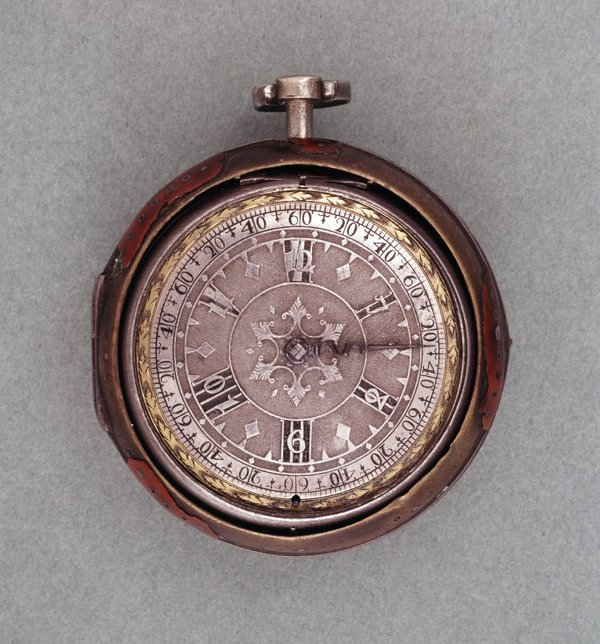
Next, a single hand with a difference – it is telescopic. The hand extends and retracts to follow the contour of the oval dial, allowing the time to be read clearly. A fixed hand would fall short at the “XII” or “VI” positions, making it harder to read with accuracy.
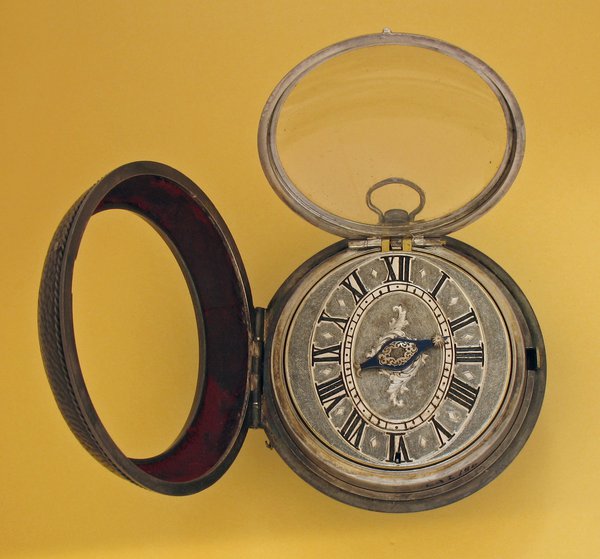

Another form of single hand can be found on this Japanese pillar clock.
The pendulum controlled movement is at the top of the clock. Below it, the single, hour, hand is directly attached to the driving weight through a slot in the case. As the weight descends over the course of a day, it indicates the time against the linear scale of numeral plaques on the case. The plaques can slide, which allows their positions to be adjusted for the Japanese system of unequal hours.
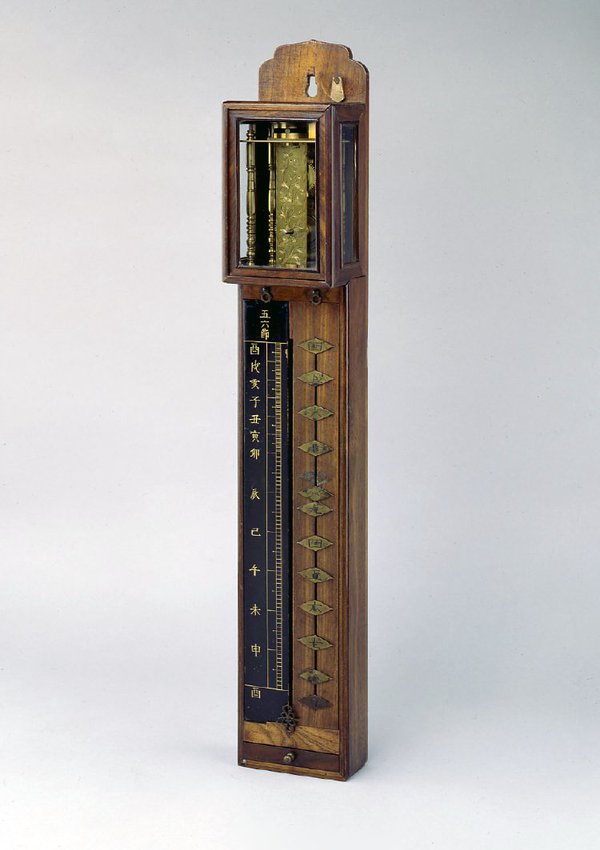
Single handed watches continue to made by several manufacturers, such as this example owned by myself.
In practice, the time can only easily be read to the nearest five minutes (which is well within the capabilities of its modern movement). However, I find that this is good enough (at the the weekends at least!) and it is a most leisurely way to follow the time.
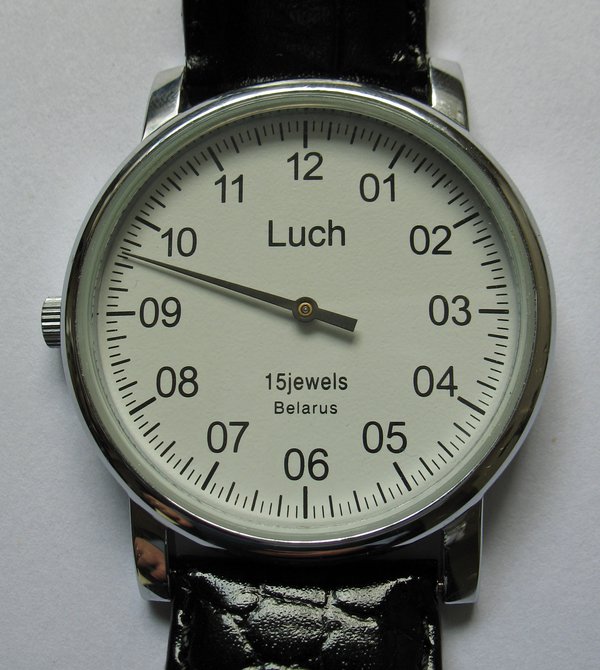
300 years
This post was written by Rory McEvoy
This year saw the tercentenary of the death Thomas Tompion (b.1639), the ‘Father of English Clockmaking’ and his life is celebrated in two special exhibitions: the first at the British Museum, entitled ‘Perfect Timing’, which focuses on the magnificent Mostyn Tompion and the second, ‘Majestic Time’, at the National Watch and Clock Museum in Philadelphia, USA.
Tompion enthusiasts should be further delighted by the announcement of the forthcoming publication of ‘Thomas Tompion, 300 years’. The book promises a wealth of new detail, fresh illustrations and includes Jeremy Evans’s previously unpublished chronology of Tompion’s life.
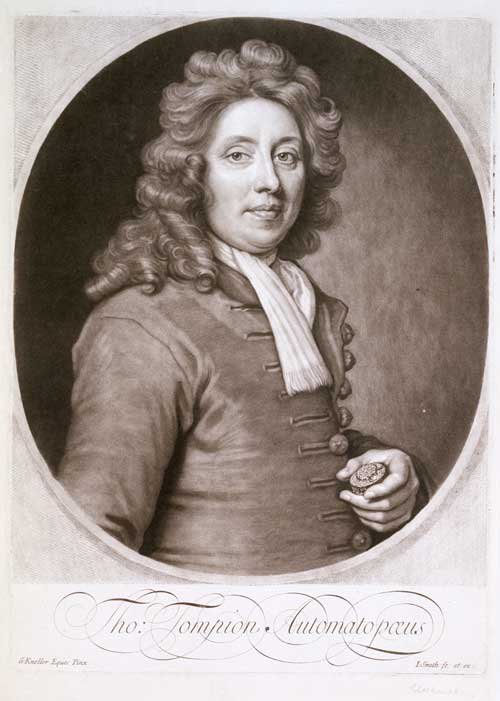
This tercentenary marks not only an end, but a new beginning as Tompion’s nephew by marriage and then business partner, George Graham (c.1673-1751), inherited and continued the business at the corner of Water Lane. As far as I am aware, the earliest announcement of Graham’s succession was first advertised in The Englishman one week after the death .
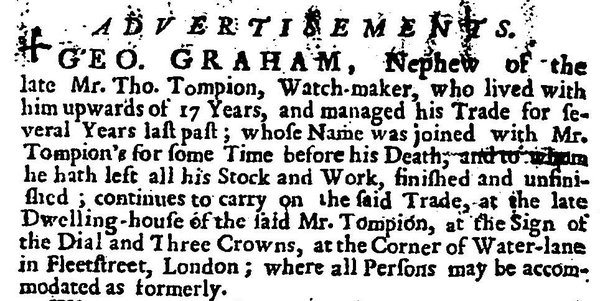
William Webster, however, did not show the same reserve. He had an advert published the day after Tompion’s death in two papers: The Mercator or Commerce Retrieved and The Englishman. His announcement of the death was a thinly veiled attempt to attract business and was repeated in various papers that week.

Unlike Webster, Graham was not apprenticed to Tompion (several publications incorrectly cite Graham as being so). He joined the household sometime around 1676 after gaining his freedom from apprenticeship to Henry Aske.
Evidence suggests that Graham did not serve his entire apprenticeship under Aske and it is currently a mystery as to where he was during the last years of his apprenticeship.
Looking forward to next year there is another important tercentenary, that of the Queen Anne Longitude Act. George Graham played an important role as an encourager and advisor to both Henry Sully and John Harrison in their efforts to produce sea-going clocks and will feature in a major exhibition at the National Maritime Museum next year.
Happiest days of your life?
This post was written by James Nye
Recently we hosted the BHI North London branch at The Clockworks. It was a great visit, filled with observations and anecdotes about life among clocks.
Always popular, we looked at the Gent’s 'waiting train’, or ‘motor pendulum’. A neat design, synchronised to an accurate source, it has the power to overcome harsh winds or snow impeding the hands, compensating with more frequent impulses when needed.
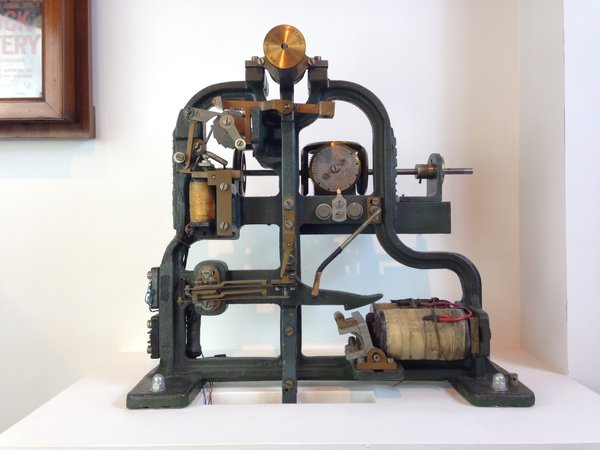
Chatting over a coffee, stories emerged of people’s introduction to clocks and watches – particularly electric ones.
I described how, at the age of 13, I was put in charge of my school’s Gents-based clock system (for the nerds, C7, C69, C150 etc), including a waiting train in a tower above. One guest mentioned that coincidentally it was the same for him – being asked to tend to just such a school system.
This prompted me to describe a feature of the system I maintained. A flatbed turret clock (David Glasgow, 1911) provided a chime and strike on bells, tripped by a solenoid, in turn controlled from the waiting train, using four aluminium sails (like a windmill) mounted on the bevel nest, operating each quarter on a microswitch – an ingenious addition.
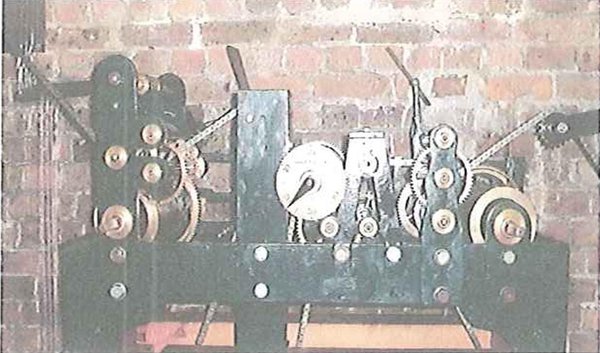


‘Which school was this?’ asked a misty-eyed guest. ‘Ardingly College’, I replied. ‘That was me,’ he said softly, ‘probably in 1950.’
A quarter century apart, we had both been responsible for the same system. George D’Oyly Snow, headmaster, was fed up with chimes sounding at the wrong time, and with limited funds, but knowing the inventive skills of his boys, he commissioned my guest to find a solution – a solution still functioning into the late 1970s.
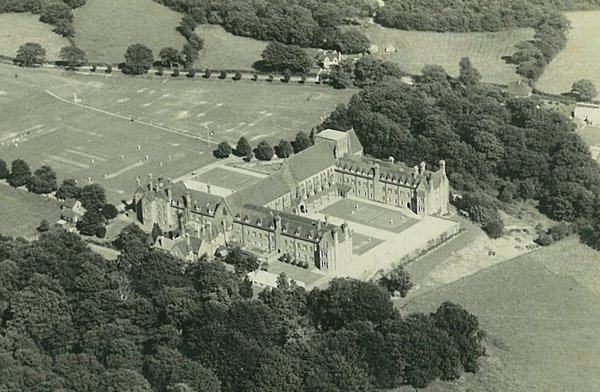
A theme I mentioned in a recent lecture is the serious risk to which electric clock systems are subject when their caretakers or installers move on.
The Ardingly Gent system, probably in service since the 1930s, was replaced after approximately 60 years by a radio-controlled master clock, and Thwaites & Reed recently reworked the flatbed movement, installing motor-wind, and even synchronization.
George Snow can rest easy in his grave – the chimes still sound on time. But to my mind they must sound a plaintive note as well – curiously, I feel desperately cheated of part of my heritage, and I know someone else who probably feels the same way.
Clocks in opera
This post was written by Peter de Clercq
If you like music as much as horology (I do!), this is for you. For the links to YouTube you need a loudspeaker or headphones.
In Rigoletto by Giuseppe Verdi, the eponymous court jester hires an assassin to murder his employer, a plan that goes horribly wrong. He meets up with the assassin at midnight (‘mezzanotte’), punctuated by twelve strikes of the turret clock. Watch it here (drag the timer to 1hr 46mins 20sec).
![Rigoletto: ‘The clocks strikes midnight’ – scored twelve times for the camp[ane], the tubular bells in the orchestra](https://ahs.contentfiles.net/media/images/bells-in-Rigoletto-Final-Act-1.width-600.jpg)
In Giacomo Puccini’s Tosca, Rome wakes up with the church bells sounding matins (early morning service). The instrument used in the orchestra is the tubular bells or chimes, metal tubes of different lengths hung from a metal frame, struck with a mallet.
The chiming is heard for more than two minutes, some bells sounding near, others in the distance. Watch it here (drag the timer to 1hr 35mins36 sec).

Modest Mussorgsky’s opera Boris Godunov has a famous scene in which the Russian tsar has visions of the child prince he is suspected of having murdered. This is popularly known as the ‘clock scene’ and as there is no clock on stage nor in the text, this must relate to what goes on in the music.
Indeed, an obstinate, repetitive see-sawing theme is heard in the orchestra, but does it signify chiming or ticking? I am not sure. Watch it here (drag the timer to 0.58 for the ‘clock’ to start).
The most striking (pun intended) appearance of clocks in opera that I know is in Der Rosenkavalier by Richard Strauss. An aristocratic lady has an extra-marital affair with a much younger man (sung by a mezzo soprano, one of the classic ‘trouser roles’ in opera).
Musing on how one day she will lose her young lover, as with the passing of time her charms will fade, she sings about the nature of time:
'Die Zeit, die ist ein sonderbar Ding. Wenn man so hinlebt, ist sie rein gar nichts. Aber dann auf einmal, da spürt man nichts als sie. Sie ist um uns herum, sie ist auch in uns drinnen. In den Gesichtern rieselt sie, im Spiegel da rieselt sie, in meinen Schläfen fliesst sie. Und zwischen mir und dir da fliesst sie wieder, lautlos, wie eine Sanduhr. Oh, Quinquin! Manchmal hör’ ich sie fliessen – unaufhaltsam. Manchmal steh’ ich auf mitten in der Nacht und lass die Uhren alle, alle stehn'
or;
'Time is a strange thing When one is living one’s life away it is absolutely nothing. Then suddenly one is aware of nothing else. It is all around us, and in us too. It trickles across our faces, it trickles in the mirror there, it flows around my temples. And between you and me, it flows again, silently, like an hourglass. O, my darling, at times I hear it flowing – inexorably. At times I get up in the middle of the night and stop all the clocks, all of them.'
The music comes to a stand-still and all you hear is the chiming of a small domestic clock, played in the harps and the celesta – it’s magical. Watch it here sung in original German, with subtitles; drag the timer to 0.19.

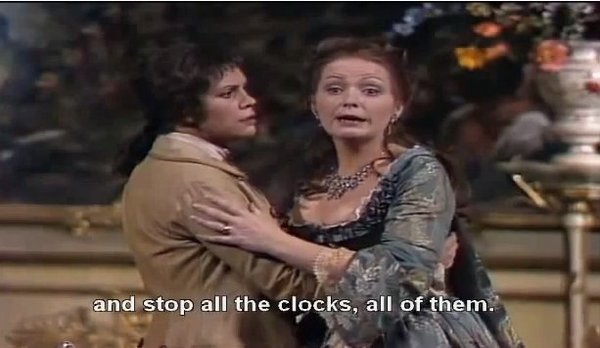
Fine timing
This post was written by Paul Buck
A new exhibition has opened in Room 3 at the British Museum displaying the year going table clock by Thomas Tompion. This magnificent clock celebrates the coronation of William III and Mary II in 1689, and was kept in the royal bedchamber. It was made by a talented and industrious man who was in the right place at the right time.

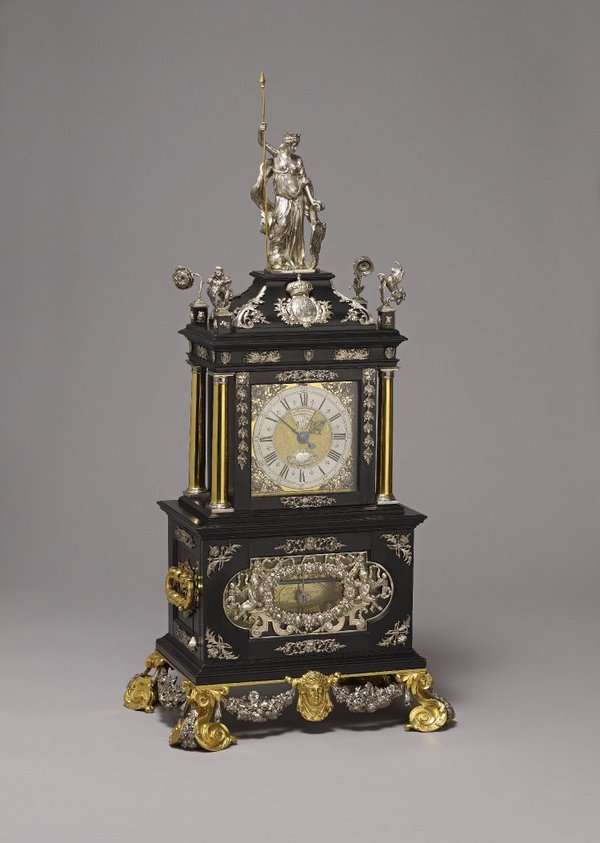
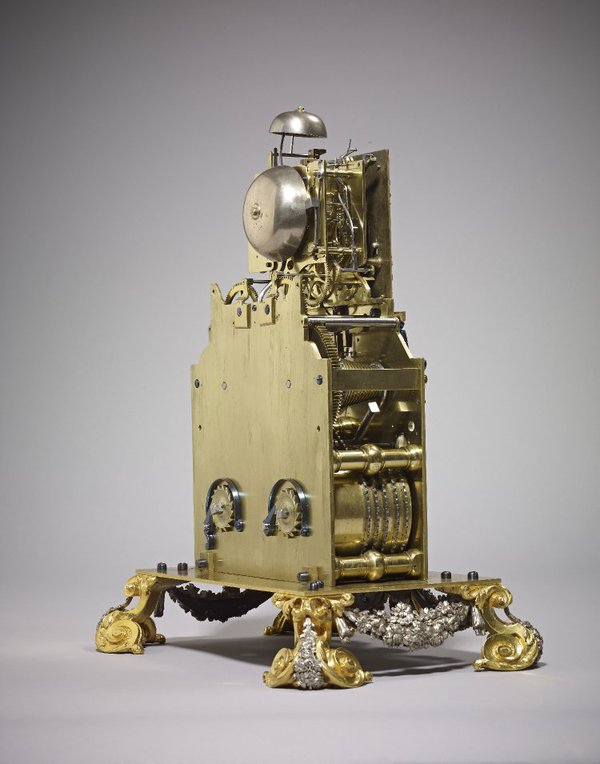
Tompion’s modest beginnings as the son of a Bedfordshire blacksmith are recorded, but after that nothing is known of his whereabouts until he appears in London at the age of 32.
Wherever he had come from, he was extremely well trained in the making of clocks and watches.
London 350 years ago was the ideal place for Tompion’s genius to shine. In the previous century, religious persecution in the Netherlands and France had led to an exodus of Protestants, including many goldsmiths, silversmiths, engravers and watchmakers who established their trades in London.
Despite the Great Fire and the plague that preceded it, 1670s Restoration London was prosperous, with a plentiful supply of wealthy clients to support the burgeoning clock and watch trade. The new accuracy in clocks resulting from the application of the pendulum in 1657 followed by the balance spring in watches in 1675 was of great interest.
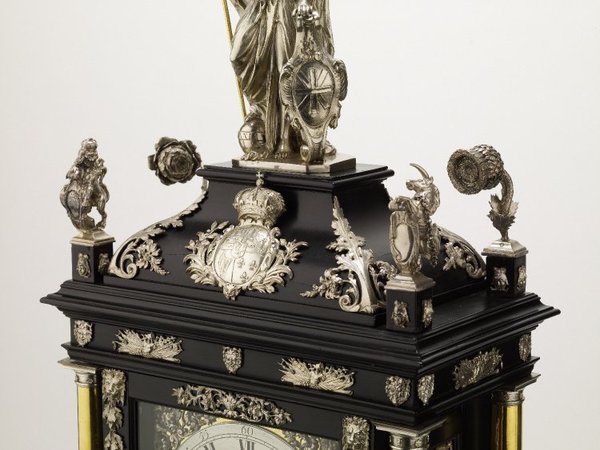
When William died the clock passed to Henry Sydney, Earl of Romney, Gentleman of the Bedchamber and Groom of the Stole. On his death in 1704, it passed to the Earl of Leicester and then to Lord Mostyn and remained in that family until 1982.
It is now known as ‘the Mostyn Tompion’ after its former owners.
The clock continues to keep good time, and is notably ‘year-going’ – it runs for over a year on a single wind. It also strikes the hours, an annual total of 56,940 blows on the bell.
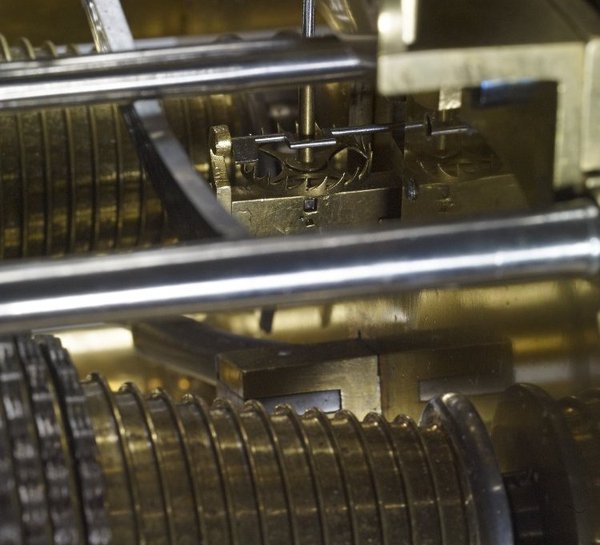
This free exhibition is timed to coincide with the 300th anniversary of Tompion’s death in November 1713 and runs until 2nd February 2014.